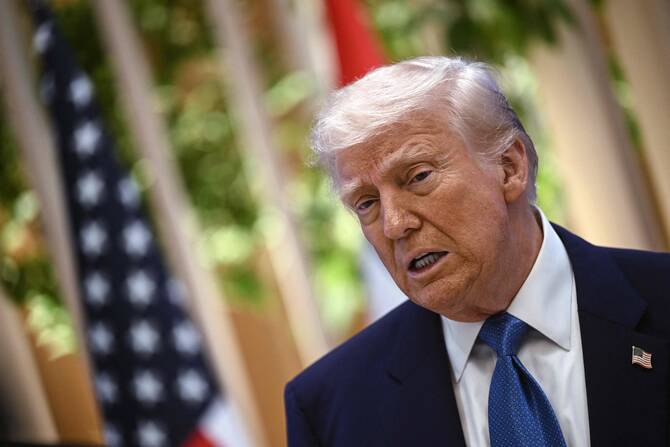
- ARAB NEWS
- 20 Aug 2025

US President Donald Trump’s decision to make Riyadh his first foreign destination in his second term was not merely a gesture of diplomacy — it was a geopolitical statement. For Saudi Arabia, last week’s visit was a powerful affirmation of its growing centrality in the international system and a clear signal that Washington continues to view the Kingdom as a key anchor of stability and influence in the region. The visit also brought tangible benefits, reaffirming old ties while ushering in a pragmatic framework for bilateral engagement rooted in mutual interest and strategic alignment.
Contrary to much of the noise in the Western media, the Saudi-US relationship is not transactional in the simplistic sense often portrayed. It is built on decades of strategic alignment — on energy security, regional stability and counterterrorism. What President Trump’s visit achieved was to reset that partnership within the context of today’s multipolar world. By choosing Riyadh as the launchpad for his foreign travels, Trump acknowledged Saudi Arabia’s unique ability to influence both regional dynamics and global markets.
This was a recognition of a transformed Kingdom. Gone is the passive, rentier state of the past. Today’s Saudi Arabia is proactive, reformist and unapologetically assertive in defining its interests. Vision 2030, the brainchild of Crown Prince Mohammed bin Salman, has fundamentally altered the country’s trajectory, moving it away from total oil dependency toward a more diversified and competitive economy. Trump’s visit, and the high-level business and defense delegations that accompanied him — including top tech leaders — affirmed that America sees a partner, not a client, in this new Saudi Arabia.
One of the most transformative and forward-looking outcomes of the visit was the spotlight on artificial intelligence. Among the most significant announcements was a joint venture between AMD and Saudi Arabia to supply high-end AI chips to support the Kingdom’s rapidly expanding data infrastructure. This partnership places Saudi Arabia at the forefront of the global AI race and signals its intent to build not just capacity, but leadership, in the technologies that will define the next century.
This deal also reflects Saudi Arabia’s evolution from a consumer of innovation to a producer and enabler of it. The AMD partnership is about more than chips — it is about building ecosystems: data centers, talent pipelines, research institutions and regional innovation hubs. In doing so, Saudi Arabia is staking a claim as both a supplier of capital and a destination for advanced technology investment.
Broader economic integration accompanied this initiative. Major investment agreements were announced across sectors — semiconductors, green hydrogen, fintech and tourism infrastructure. These deals represent a maturing economic relationship, where capital flows in both directions and where Saudi Arabia is increasingly seen not only as a global investor but also as one of the world’s most dynamic emerging investment destinations.
Trump’s endorsement underscored that Saudi Arabia remains Washington’s first call when the region demands leadership.
Ali Shihabi
Security cooperation, always a cornerstone of the bilateral relationship, received renewed emphasis. While much has been made of arms sales, the real story is the shift toward defense self-sufficiency. Agreements announced during the visit included technology transfer, joint production initiatives and a more agile procurement framework. Saudi Arabia is not merely buying weapons — it is building capabilities, infrastructure and domestic expertise.
This is part of a broader Saudi strategy: to maintain a credible deterrent in an increasingly volatile region while reducing reliance on any single external partner. The Trump administration appears to understand this nuance and is aligning US defense policy accordingly. Cooperation will continue, but on terms that respect Saudi sovereignty and its aspirations for strategic autonomy.
The timing of the visit, in the midst of evolving regional dynamics, enhanced Saudi Arabia’s diplomatic leverage. President Trump’s presence reinforced Riyadh’s role as a central convening power in the Middle East. At a time when Saudi envoys are engaging constructively with regional neighbors, managing conflicts and facilitating dialogue, Trump’s endorsement — particularly his positive response to the crown prince’s request that the Syria sanctions be lifted — underscored that Saudi Arabia remains Washington’s first call when the region demands leadership.
This visit helped strengthen coordination between Riyadh and Washington on regional threats, including issues related to Iran, maritime security and nonstate actors. Saudi Arabia continues to seek peaceful resolutions to regional tensions but remains firm in its need for security assurances. Trump’s visit provided that reassurance while supporting Saudi Arabia’s broader regional outreach efforts.
Beyond the formal agreements, the visit had immense symbolic value.
The optics matter — especially as Saudi Arabia pushes to redefine its image internationally. The Kingdom is no longer just a commodity exporter — it is an aspiring hub of ambition, innovation and cultural revitalization. Hosting the US president in Riyadh signaled that Saudi Arabia is not just a player in the region but a key architect of the future Middle East.
In sum, President Trump’s 2025 visit gave Saudi Arabia what it wanted most: a reaffirmation of its strategic value, economic validation and a platform to project its new identity to the world. This was not a visit anchored in nostalgia or dependency. It reflected a recalibrated partnership between two sovereign nations with overlapping — but not identical — interests. And in this new era of great power competition and regional realignment, Saudi Arabia walked away from the visit not as a junior partner but as a confident, indispensable ally.